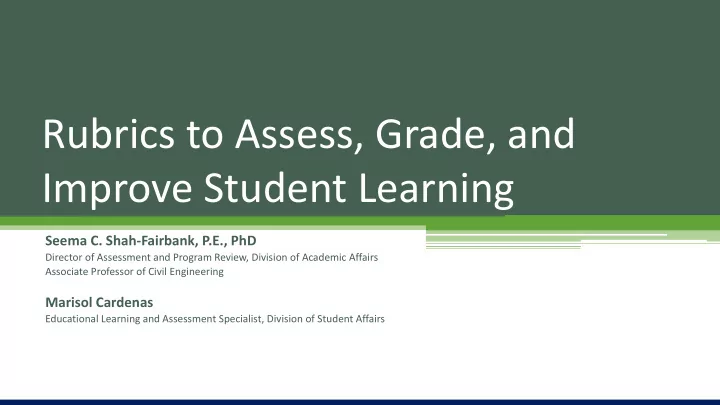

Rubrics to Assess, Grade, and Improve Student Learning Seema C. Shah-Fairbank, P.E., PhD Director of Assessment and Program Review, Division of Academic Affairs Associate Professor of Civil Engineering Marisol Cardenas Educational Learning and Assessment Specialist, Division of Student Affairs
Learning Objective During Workshop • Differentiate between the three different types of rubrics. • Describe the purpose of the rubric. • Identify the components of a rubric. Post Workshop • Design a rubric to assess and grade student work.
Rubric Types SINGLE POINT GRADES STUDENT WORK BY SPECIFIC COMPONENTS STUDENT WORK IS COMPARED TO THE PROFICIENT LEVEL, DOES NOT PROVIDE STUDENTS WITH INFORMATION ON HOW TO IMPROVE INSTRUCTOR NEEDS TO PROVIDE MORE WRITTEN COMMENTS, WHICH CAN BE TIME CONSUMING.
https://www.cultofpedagogy.com/holistic-analytic-single-point-rubrics/
What are rubrics? • Exams Rubrics are not a • Presentation • Oral form of assessment , • Poster but are the criteria • Written Assignment • Project/Report for making an • Essay assessment. • Reflection • Observations • Artifact Analysis Are Tools to Evaluate • Reflection Papers Student Work • Journal Art Pieces • Resumes
How to create a Rubric? • Consider which learning outcome or outcomes you need to assess/grade. • Determine if the assessment is for a particular course or program. 1 • Determine what a student should learn from the outcomes. • Develop criteria for evaluation 2 • Define the levels of achievement • Define the grading scale 3 • Develop verbiage that provide quality dimensions 4 • Select artifact (assignment or work product) to evaluate with rubric • Score/Assess artifact, which provides feedback to student 5 • Modify rubric if needed
1 Identify the Outcome • Learning outcomes – ▫ Examine what a student (or other stakeholders) is to do or think as a result of the program, course, service. • Program outcomes – ▫ Examine what a program or process is to do, achieve or accomplish for its own improvement; generally needs/satisfaction driven.
1 Learning Outcome to be evaluated Students will be able to ………. Provide a written summary of a laboratory experiment.
2 Criteria to Evaluate and Levels of Achievement Criteria Very Good Good Satisfactory Inadequate (5pt) (4pt) (3pt) (1 pt.) Objective Methodology Data Collection Calculations Analysis and Results Conclusion
3 Define levels of achievement for each criteria Very Good Good Satisfactory Inadequate Criteria (5pt) (4pt) (3pt) (2pt) Objective for the All objectives for the One or more of the experiment was not experiment are clearly All objectives are Objective objectives have errors accurate (student did and correctly correctly presented. in their presentation. not actually state the presented. correct objective.) Methodology Data Collection Calculations Analysis and Results Conclusion
4 Develop verbiage that provide quality dimensions Very Good Good Satisfactory Inadequate Criteria (5pt) (4pt) (3pt) (2pt) Objective for the All objectives for the One or more of the experiment was not experiment are clearly All objectives are Objective objectives have errors accurate (student did and correctly correctly presented. in their presentation. not actually state the presented. correct objective.) Methodology Data Collection Calculations Analysis and Results Conclusion
3 4 2 Evaluate Measures Skills Define the Quality • Objective Level of Criteria to Dimensions • Subjective Mastery Evaluate • Higher-Order Learning Criteria Mastery Developing Introductory Mastery Developing Introductory Purpose appropriate to audience. Central Purpose somewhat appropriate to Purpose inappropriate to audience. Purpose/ Central message is clearly stated and very well audience. Central message is stated but Central message is partially stated and developed. Purpose of assignment could be further developed. Purpose not may be vague and not explicit. Purpose Message achieved. completely aligned with assignment. not aligned with assignment. Presentation is logically sequenced and Presentation may be coherent overall but Presentation lacks logical sequence or Organization purposeful presents some inconsistencies coherent structure. A listener can easily follow the line of Claims somewhat supported with Support lacking for claims and main ideas, Content reasoning evidence. Gaps in reasoning. listener cannot follow reasoning. Language is inappropriate to audience, Language is mostly appropriate to Language ((word Language is appropriate to audience, situation, or purpose. Language choices audience, situation, or purpose, but does situation, and purpose. Language choices undermine the effectiveness of the not always advance the intended meaning choice and precisely convey the presenter’s intended presentation or do not advance the or the effectiveness of the presentation. meaning and enhance the effectiveness of intended meaning of the presentation. (e.g. Language may be simplistic, casual, arrangement)) the presentation overly casual, wordy, confusing, imprecise, imprecise, or oddly structured. reductive, or even offensive). Delivery techniques make the presentation Delivery techniques make the presentation Poor delivery techniques detract from the Delivery/ Platform engaging and speaker appears understandable, and speaker appears understandability of the presentation, professional. relatively prepared. and/or the speaker appears unprepared. Presence
Do you need a Rubric? □ You are getting carpal tunnel syndrome from writing the same comments on almost every student paper. □ it’s 3 A.M. The stack of papers on your desk is fast approaching the ceiling. You’re already 4 weeks behind in your grading, and it’s clear that you won’t be finishing tonight either. □ You have graded all of your papers and worry that the last ones were graded slightly differently from the first ones. □ You give a long narrative description of the assessment in the syllabus, but the students continually ask two or three questions per class about your expectations. Rubrics set you on the path to addressing these concerns.
Why make a rubric? Contains Communicates Assessing Scoring Expectation Student Work Achievement Criteria Level Supports Learning Feedback Directions on Consistent, Demonstrates Plan what is good Efficient & ways to improve activities Objective accordingly
Recommend
More recommend